Book contents
- Frontmatter
- Contents
- List of contributors
- Series editors' preface
- Preface
- Introduction
- I PHILOSOPHICAL UNDERPINNINGS OF SECOND LANGUAGE WRITING INSTRUCTION
- Chapter 1 Second language composition instruction: developments, issues, and directions in ESL
- Chapter 2 L1 composition theories: implications for developing theories of L2 composition
- Chapter 3 An overview of second language writing process research
- Chapter 4 Coaching from the margins: issues in written response
- Chapter 5 Second language writing: assessment issues
- Chapter 6 Reading–writing connections: toward a description for second language learners
- II CONSIDERATIONS FOR WRITING INSTRUCTION
- Index
Chapter 2 - L1 composition theories: implications for developing theories of L2 composition
Published online by Cambridge University Press: 05 October 2012
- Frontmatter
- Contents
- List of contributors
- Series editors' preface
- Preface
- Introduction
- I PHILOSOPHICAL UNDERPINNINGS OF SECOND LANGUAGE WRITING INSTRUCTION
- Chapter 1 Second language composition instruction: developments, issues, and directions in ESL
- Chapter 2 L1 composition theories: implications for developing theories of L2 composition
- Chapter 3 An overview of second language writing process research
- Chapter 4 Coaching from the margins: issues in written response
- Chapter 5 Second language writing: assessment issues
- Chapter 6 Reading–writing connections: toward a description for second language learners
- II CONSIDERATIONS FOR WRITING INSTRUCTION
- Index
Summary
In the 1980s, English as a second language (ESL) composition research and teaching developed and matured to an extent never imagined by the oral/aural proponents of the 1960s and early 1970s (see Silva's chapter in this volume). So far, however, most of this research and pedagogy has been drawn, in bits and pieces, from research in first language (L1) composition, which in turn is based upon L1 theory. Unfortunately, there has as yet been little discussion of the development of coherent and complete theories of ESL composition as allied to – or separate from – the various theories of L1 composition.
This chapter addresses the issue of ESL composition theory development with two intents. The first is to suggest that a discussion of ESL composition theory should conform to some basic requirements for completeness – that is, it should encompass the values and relationships among basic components in composition (the writer, the topic, etc.). The second purpose of this chapter is to present three approaches to composition theory, drawn from L1 literature, for consideration by teachers. Zebroski (1986: 57) suggests that “if we write and teach writing, we have a theory of writing by definition.” As teachers, we will benefit from becoming aware of our theories and the assumptions that underlie them.
Because L1 theory is rich in both history and substance (see, e.g., Fulkerson 1979), it is necessary to select one of several comprehensive models from which to work in order to classify essential components.
- Type
- Chapter
- Information
- Second Language Writing (Cambridge Applied Linguistics)Research Insights for the Classroom, pp. 24 - 36Publisher: Cambridge University PressPrint publication year: 1990
- 15
- Cited by



